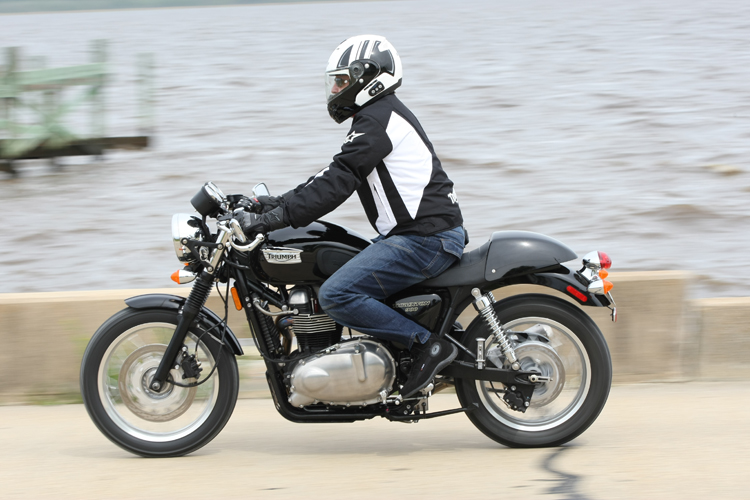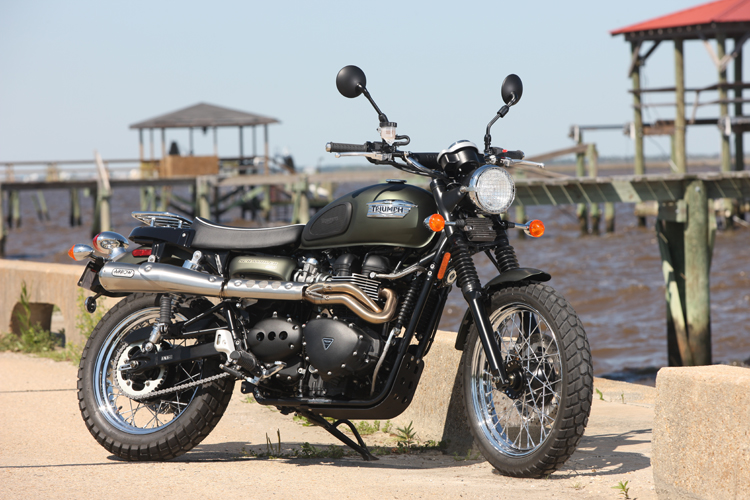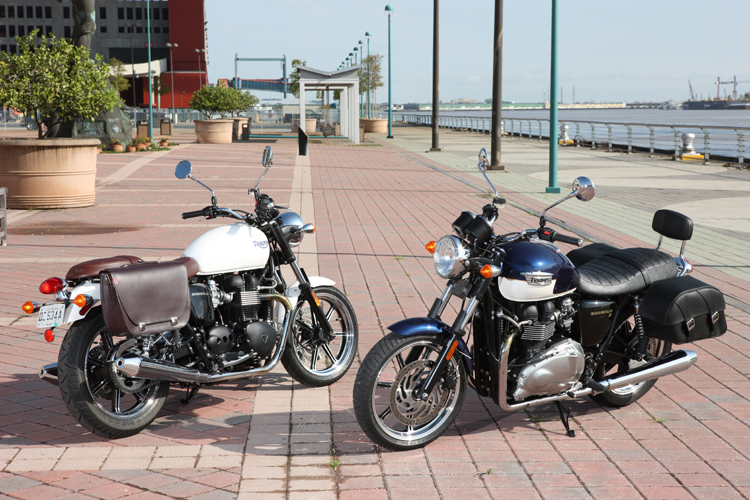Triumph Modern Classics

In 1959, Triumph's legendary 650cc Bonneville began rolling from showroom floors. Named after the Bonneville Salt Flats, where speedster Johnny Allen had piloted a Triumph-powered streamliner to record velocities three years before, this model would go on to become one of the iconic machines in the history of motorcycling.
Right from the start, the Triumph Bonneville's seamless balance of form and function mesmerized just about every segment of the motorcycling community throughout the 1960s and '70s. Whether rebellious "rockers," renowned racetrack heroes, Hollywood elites, or everyday riders, very few two-wheeled enthusiasts were ever immune to the Bonneville's twin-piston charm. When Triumph finally bolted the doors of its Meriden, England factory in 1983, the Bonnie, having then grown to 750cc, may have been gone, but it was certainly not forgotten. Prized equally as collector's item and hip, everyday ride, the former British company's flagship model inspired a loyal, never-say-die following that lives on to this day.
When Triumph Motorcycles Ltd. of Hinckley, England reemerged in 1990, their solid foundation of modern multi-cylinder bikes was quite impressive. Despite this, the motorcycling public refused to allow the spirit of the machine that moved so many to fade into oblivion.
In 2001, the Bonnie was reborn with a 790cc parallel twin and a host of familiar styling cues thoroughly steeped in the Age of Aquarius. With the dawning of 2009, that single bike has evolved into a five-model line that now boasts 865cc and the Modern Classics moniker. And it's a good name indeed; the retro feel is right on the money. Strains of "Quadrophenia" and "Highway 61 Revisited" seem to pour from almost every crevice. Though mechanically contemporary, these machines possess a mojo that entices longing stares from both the hip crew of today and those sporting touches of gray.

Bonneville and Bonneville SE
There have been plenty of attempts to recreate yesterday's favorites on up to date platforms. Some have worked fairly well, though most usually garner a half-hearted "nice try." But in this instance, the team from Hinckley has the WABAC machine dialed in almost perfectly. Immediately, upon throwing a leg over the new Bonneville, I was taken by how closely it's overall ambiance compares to those of the 1970s. The flat seat, slender fuel tank, and fall-into-the-hands handlebars all conspire to throw open the sparkle helmet and bellbottom floodgates. A low 29.1-inch seat height and comparatively small dimensions also season the throwback formula. With my spine straight and feet perched on centrally mounted foot pegs, it's nice to be atop a "proper" motorcycle once again. Even at 5'-10", I'm comfortable and not the least bit cramped. The tall-stemmed, round rearview mirrors that offer great vision are neat too, and they add an extra glint of old-school chrome.

And with scoots long-forgotten overflowing the memory banks, there's no need to ruin those fond recollections with worries about fickle, flooded Amals. Today's procedure for getting the motor running is pain-free. Gone are dribbles of gasoline from the carb ticklers and that stout-booted leap of faith. Now, all it takes is a thumb to the button and the closed loop multipoint EFI takes care of the rest. And don't feel bad if you're fooled by the Keihin fuel injection system - it's very cleverly disguised as a twin carburetor setup that will trick the most well-trained eye. Yes, there's some mystique about kick-starting a big twin that's partly mechanical and more parts magic, but I'll take electric cold starts any day.
Once under way, the Bonneville and Bonneville SE models exhibit a light and precise demeanor. The 67-horsepower, 825cc engine is superbly fed by the aforementioned EFI, with a small hitch occasionally surfacing when getting back on the throttle - nothing to upset the applecart though. A four-position adjustable lever operates the buttery smooth clutch, and the 5-speed tranny is smooth and precise. Twin balance shafts allow enough character pulse to shine through without sacrificing a smooth ride, and that holds true beyond posted highway speeds. The sound emanating from the catalyst-equipped, megaphone-style pipes is somewhat quiet, but still replicates that groove from the past. For those wanting a little more thump, a sweet-sounding selection of Arrow exhausts is available from Triumph's accessory catalog.

Although traditional in appearance, this chassis has far outgrown the disco era. Shod with lightweight 17-inch, seven-spoke alloy wheels and Metzeler tires, these bikes are pure fun whether dicing through rush-hour traffic or arcing across your favorite country road. A strong, tubular steel, cradle-type frame with 41mm Kayaba forks and chromed twin rear shocks keep the ride remarkably stable and comfortable on all but the nastiest roads. Another 21st-century aspect we old-timers can appreciate is the braking system. While single discs front and rear did grace the later model Bonnies of yore (we won't even discuss those outfitted with drum brakes), they required firm inputs and delivered marginal results. Not so on the latest generation. Their front and rear twin-piston calipers very effectively grab 310 and 255mm discs respectively. The action is smooth and easy to modulate with minimal effort required for solid stops. And like the clutch, the front brake lever is four-position adjustable.
When comparing the Bonneville and the SE, only taste and Ben Franklin's wily smirk dictate any real differences. The variations between the two are purely cosmetic. The SE pays a bit more homage to its roots with such touches as a matching speedo and tach set, polished alloy engine covers, and especially that cool, raised metal tank badge. It also carries a MSRP that is $ 700 higher. Regardless of the trim, a blast from the past with contemporary comfort and reliability awaits anyone taking it to the streets on one of these beauties.

Bonneville T100
The Bonneville and the SE may seem too newfangled to others, however; and for them the T100 might strike the right chord. Though the engine and frame are the same, a few distinct touches ought to keep the Meriden purists from stomping off in a huff. First, it has spoke rims and a 19-inch wheel out front. That larger hoop does have a stable, straight-line presence and is more historically true to form, but its prowess in the twisties is somewhat compromised. In back-to-back comparisons with its siblings sporting seventeens, the T100 comes off a bit sluggish.

Other nice T100 bits that help seal the retro deal include fork gaiters, chrome engine covers and a two-tone paint scheme complete with a chrome tank badge. The twin "pea-shooter" exhaust silencers scream swingin' sixties, but that funky kink in the pipe just below the foot pegs still mars the facade.
Thruxton

If you're going to pay homage to the Bonneville legend, then it seems only appropriate to offer a salute to the café racer. The Thruxton is a racy replica of the modified machines that blitzed across the English countryside. Low, clubman-style bars and rear-set foot pegs are accented by a slick, racing stripe running the length of the fuel tank and rear fender. Nicely chromed spoke wheels complete the package. Granted, the Thruxton's riding position may not be ideal for long days in the saddle, but none of the ton-up boys had grand touring in mind back in the day. Handling is light and responsive thanks to the slightly smaller 18-inch front wheel, which makes this bike a real treat when the tarmac knots up.
Scrambler
We all have a little Steve McQueen in us, and Triumph's Scrambler is an excellent way to let him out. This rugged unit may look poised to leap barbed-wire fences, but that activity is still best left to stuntmen. The matte khaki-green and jet-black paint options exude a no-nonsense aura complementing the aggressive dual-sport tires; and though it's no dirt bike, the Scrambler deftly devours gravel roads while saving highways and mountain twists for dessert. A cool set of high pipes complete the retro roughneck look perfectly. In summary, having fun on this bike is a given. But as for making it home in time for supper and not tracking dust through the house, that's another discussion.
Accessories
With the sixties and seventies vibes these machines are laying down, it's natural to want clothing styles to match those eras. No worries there either. Triumph has an extensive selection of men's and ladies' jackets, gloves, boots and pants to make the Modern Classic statement a top-to-bottom affair. There are also numerous throwback tee shirts, hats, and even belts available.
And clothes aren't the only finishing option offered. Triumph has tons of mechanical and accessory goodies in their catalog to help create a bike that's all your own. From their Arrow exhaust systems that cut weight while adding a more distinctive rumble, to bags, racks and seats, the list is extensive and endlessly tempting.
Thinking about all those great, old rides of the past is a source of non-stop enjoyment. To be able to revisit those times on a hassle-free, late-model machine is even better. Triumph's reasonably priced Modern Classic lineup has given us the opportunity to do just that - and perhaps the best part is, that dreaded kick-starter stays safely locked away in the memory vault.
Triumph Engineered by Alpinestars
AS4 Tex Jacket
This comfortable jacket is an impressive mix of the style we've come to expect from Triumph and the real-world protection typical of Alpinestars. The elbows and shoulders are equipped with CE-certified protectors and PE foam padding in the back and chest. The armor was never obtrusive, and even on longer rides comfort wasn't compromised. The 100-percent polyester, 600D outer construction kept us dry even through several light rains, and the easily removable thermal liner is nice to have on standby in case temperatures nosedive. Generous front pockets zip shut securely and are easy to access for handy storage of smaller items. Ventilation could be better, and while the outer material is breathable, the jacket gets a little warm on sunnier days, with its predominantly black color scheme contributing. That one beef aside, the AS4 proved to be an excellent companion during our four-day ride.
AS3 Carbon Glove
The fit and finish of Triumph's Hard Carbon Gloves have always been RoadRUNNER favorites, and Alpinestars ability to put together a superior pair of mitts goes without saying. Combine those factors and the result is predictably excellent. Constructed of full-grain leather, these gloves are supple and offer excellent feel right out of the box. Even with carbon-fiber knuckle protectors in place, they never felt stiff and became more comfortable as they loosened up. Leather and synthetic suede palm reinforcements are there to increase grip, and they also team with rubber pad inserts to protect against abrasion. Thankfully, we never had to test that feature. But in the event a get-off occurs, twin Velcro® cuff closures and a separate Velcro® wrist strap ensure that the AS3s aren't going anywhere.




















